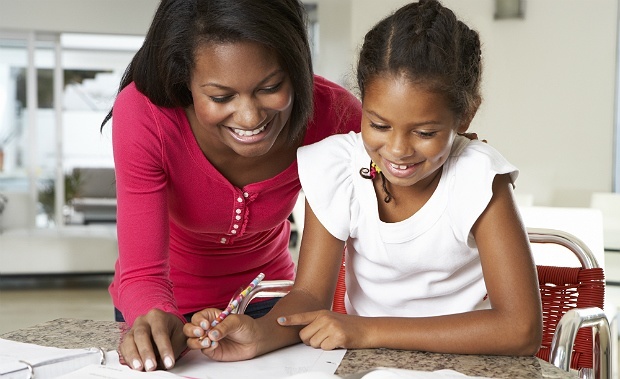Every purchase at the corner store is a lesson about basic arithmetic. Every street sign is another word to sound out. At least that’s one theory of how parents can help their children develop academic skills. Whether or not you count out every transaction with your child, it’s always true that parents are the first teachers for their children. We pass on bits of knowledge, serve as examples and even unconsciously teach kids to grasp basic abilities like language.
But we still tend to think of education as a task fundamentally divided between home and school. Schools teach “subjects,” facts and techniques particular to specific domains of knowledge, and parents teach “values,” handing down moral traditions and common sense principles like diligence and perseverance.

In reality, these two tasks aren’t separated. It is, after all, a child’s values that will allow them to prioritize the knowledge they’re receiving in the classroom. When they learn about specific issues, the morals we pass down determine which issues they consider particularly important, and learn more about. School informs home and home informs school. As parents, we “craft” our children, in a very real sense, through example and direct education. Those lessons we teach don’t just fly out the window once they enter a classroom
1. Be Imperfect
Children pick up on far more than what we tell them. Every choice we make, as parents and as people, stands as a behavioral model for our kids. It tells them “this is how a person acts,” and those choices structure how they come to understand human behavior, human struggle and human achievement.
That doesn’t mean being perfect is required to be a good, or even great, parent. Education, and improving a child’s chances of succeeding in school, isn’t about being perfect. It’s about being imperfect, but having the courage and skills to improve, to face up to set-backs, rather than shy away from them, and above all, to be curious about the world around us everyday. That’s the best model to set for a school-aged child: that we are all learners.
2. Make Your Home An Intellectual Environment
That doesn’t mean piping Bach, or worse, Stravinsky into your child’s room at all hours, or sitting them on your lap for a good read-through of Homer’s Odyssey. It can mean those things, and exposing your child to examples of artistic and intellectual achievement is a wonderful thing, but there’s far more to creating a positive home environment where learning is concerned. So what does an intellectually-stimulating environment look like?
The standard guide is something called the Home Observation for Measurement of the Environment (HOME) Inventory. It’s an evaluation tool that researchers often use in their studies to figure out which changes in the home environment can increase the likelihood of a child’s success at school. That might not sound very helpful to how you interact with your child on a day-to-day basis, but it’s instructive to look at what the HOME Inventory considers valuable.
The most important thing to notice about HOME is that it takes a holistic approach. Rather than focusing on how, and how often, parents bring up math and reading in the home, the inventory also stresses compassion and warmth, intimacy and acceptance, values we would usually consider “social” and not necessarily “educational.” HOME doesn’t disregard the positive impact of traditionally “educational” interactions. Stimulating a child’s language skills, by challenging their current vocabulary with new words, has a strong impact on how well kids do in their classes. But HOME takes interactions like that as only one aspect of a healthy environment, placing an equal emphasis on physical security, parent responsiveness and a home’s “emotional climate.”
3. Change With Your Child
It’s also important to note that the HOME Inventory changes drastically as children age. As infants and toddlers, children show educational improvements when their parents engage them regularly with eye contact, caresses and speech (which doesn’t need to be “educational,” or intellectual in nature to have this effect). Once children reach the age of 3, HOME veers away from these basic forms of contact to the maintenance of reasonable boundaries (like “you’re not going to get everything you want immediately just because you cry”).
Perhaps most important, though, is exposing your child to a wide variety of educational experiences. Focusing disproportionately on math skills might make your child better at arithmetic, but it doesn’t go very far in terms of reading. That’s obvious, but the crucial point is that you’re not just teaching your child specific facts, like how to add and subtract or how to sound out a word. You’re teaching your child how to learn, which isn’t a matter of brute repetition. It’s about giving your child the “how” and the “why” as well as the “what.”
Why do we study mathematics? There are numerous reasons, from helping us recognize patterns in the world to understanding how we know when we’re right. But each of these explanations leads us down a long, twisting path of inquiry that touches on numerous domains of human knowledge. The importance of mathematics isn’t an isolated fact, and neither is the fact that the ratio of a circle’s circumference to its diameter comes out to 3.14159, or pi. In reality, pi was a radically practical discovery, allowing ancient peoples to determine how big circles were and build incredible new structures. Obviously, pi isn’t just a mathematical principle, a fact. It’s the being of a discussion about history, philosophy, science – some of the most important things we can think about as humans. Every fact that you can help your child understand works in the same way, as the beginning of a conversation.
4. Emphasize Acceptance & Encouragement
Brains aren’t enough, though, to help children become life-long learners. In study after study, warm, caring homes where kids feel both intellectually and emotionally supported have been shown to increase their success in reading and math at school.

By engaging their kindergarten-aged children in basic mathematics activities at home, mothers improve their test scores at school. That’s not surprising, but when you add a positive home environment to the equation, those test scores are boosted even further. Look to families where conflict often disrupts the mother-child relationship, and those test scores drop, according to a 2006 study from the journal Parenting. whether or not parents help their children with basic math skills at home.
Acceptance and encouragement, according to HOME, are the cornerstones of a healthy home environment, no matter a child’s age. Parents who encourage their children to be curious about the world, encourage them to pick up on new words, learn new colors and explore are doing their kids a great service.
Acceptance is the necessary correlate of this sort of encouragement. Children do better at school when they’ve been raised in an environment that stimulates their desire to explore, rather than discouraging it. That means punishments and scolding should be kept to a minimum, since reprimands ultimately tamp down a child’s natural curiosity. More effective than punishing a child is allowing them to understand the consequences of their actions through experience. Instead of raising your voice when your child spills orange juice at the table, calmly ask them to clean up the mess. Not only will they learn how to handle accidents when they happen, your child will also begin to learn that being more careful in the first place can save them trouble in the long-run.
5. Get Involved
Attending parent-teacher conferences, visiting your child’s classroom, volunteering on field trips: these aren’t just ways to check up on your kid. Family involvement in school settings has a positive effect on a child’s educational outcomes. In fact, blurring the separation between education in the home and education in the school is probably a good thing. The study results on this issue are extremely interesting, and somewhat counter-intuitive.
Take for example, this paper, which looked at how changes in family involvement at school affected the literacy skills of low-income children. When parents got more involved over the course of their child’s education (the study tracked children from kindergarten to fifth grade), their reading and comprehension skills improved, outpacing the skills of children whose families became less involved over time. But even more interesting, increasing family involvement wiped out the initial gap in literacy skills between children from families with lots of formal education and families with less formal education.
The positive effect of parental “interventions” at the school building may be even greater for children whose skills are currently lagging behind those of their peers. Other studies, like this paper published in the Journal of School Psychology, found that parental involvement in the kindergarten classroom improved a child’s social skills, reduced instances of “problem behaviors,” but had no effect on a child’s vocabulary skills, the educational outcome under investigation. Similarly conflicting results have been observed elsewhere, with parent involvement increasing social skills but leaving classically “educational” skills unchanged, or vice versa, improving language skills but failing to reduce problem behaviors. Few studies, however, have found no effect on both counts. In other words, parental improvement seems to spur positive change, even though it’s unclear what will be changing.




